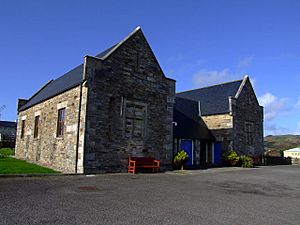Irish Poor Laws facts for kids
The Irish Poor Laws were a set of rules and laws made by the government to help people who were very poor in Ireland. Before 1800, some laws were already in place. But the most important law was passed in 1838. It was very similar to a law already used in England. This new law aimed to help many people struggling with poverty across Ireland.
Contents
Early Efforts to Help the Poor
Before Ireland joined with Great Britain in 1800, its own parliament tried to help poor people.
What Were Foundling Hospitals?
In 1703, a law was passed to create places called "workhouses." These were meant to help poor children, especially those who had been abandoned (called "foundlings"). The goal was to care for them and teach them skills so they could get jobs.
Houses of Industry
By 1771, there were "Houses of Industry" in every county. These places offered work and shelter to poor adults. By 1833, running these houses cost a lot of money, about £32,967. This was a large sum back then!
New Laws After 1800
After Ireland became part of the United Kingdom in 1800, the way poverty was handled changed. The "Houses of Industry" were much smaller in Ireland compared to England and Wales.
How Poor Law Unions Worked
A big study in 1833 led to the Irish Poor Law Act of 1838. This law created special areas called "poor law unions." Three special "poor law commissioners" divided Ireland into these unions.
- What was a Poor Law Union? Each union was a group of smaller areas called "electoral divisions." These divisions were made up of even smaller areas called "townlands."
- Where was the Help Given? In each union, there was a main town where a workhouse was built. This workhouse was the center for helping the poor.
- What was Poor Relief? People who were very poor, called "paupers," could get "poor relief." This meant they could get help either by staying in the workhouse (called "indoor relief") or sometimes by getting help outside the workhouse (called "outdoor relief").
- How Was it Paid For? This help was paid for by a special tax called a "poor rate." This tax was based on how much land or property people owned.
- Who Ran the Unions? Each union had a group of people called a "board of guardians." These guardians were elected by people who paid the poor rate. If someone paid more tax, they had more votes!
During and after the Great Famine, many people became very poor. So, the boundaries of the unions in the west of Ireland were changed. They made more, smaller unions to make it easier to manage the help needed.
Emigration During the Famine
The Great Famine was a terrible time when many people in Ireland starved or got sick. The workhouses became too full. So, many poor people were helped to leave Ireland and move to other countries. This was called "assisted emigration."
However, this also meant that more people wanted to enter the workhouse, hoping they would also be sent away from the famine. To manage this, the guardians decided that only people who had stayed in the workhouse for more than two years could get help to emigrate.
Changes After Ireland Divided
After Ireland was divided into two parts (the Irish Free State and Northern Ireland), the poor laws changed again.
In the independent Irish Free State, the poor law unions and rural districts were stopped in 1925. The county councils took over the job of helping the poor.
In Northern Ireland, the poor law unions continued until 1948. Then, a new health and social care service took over.
See also
- Scottish Poor Law
- English Poor Law
- List of Irish Poor Law Unions


